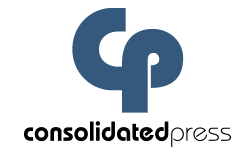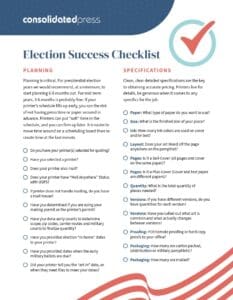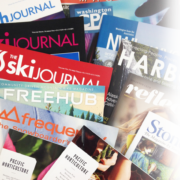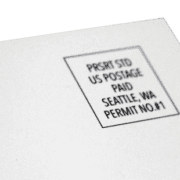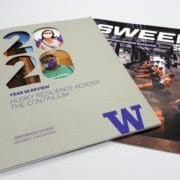Strategizing for election success
Print and mail campaigns can maximize voter turnout and positive results
Political campaigns heavily rely on print campaigns, especially in states like Washington that exclusively use mail-in ballots, printed materials and direct mail campaigns play a crucial role in reaching voters. Governments, candidates and political groups need to collaborate on a comprehensive plan with their commercial print partners to ensure a smooth and effective election-focused mailing in vote-by-mail states.
Understand the Mail-In Ballot System
In states where mail-in ballots are the primary voting method, it is crucial to have a thorough understanding of the deadlines and regulations governing the process to help shape the messaging and timing of the campaign to align with the election timeline.
Tailor Materials for Vote-by-Mail Voters
In states like Washington, where voters receive their ballots by mail, printed materials take on an even more critical role in engaging and informing voters. Governments and political parties should develop materials that educate voters about the voting process, highlight key issues, and provide clear instructions for completing and returning mail-in ballots. Design compelling brochures, flyers, and informational inserts that address common questions and concerns.
Collaborate with Printers That Have Election Expertise
Download our election checklist
Collaborating with experienced commercial printers is vital to the success of any election-focused mailing. Consider these aspects when working with printers:
Has your printer done this type of work before? Choose a printer with experience and knowledge in executing election mailings in your state. In Washington, Oregon, and California, they should understand the unique requirements, regulations, and deadlines associated with mail-in voting. Their knowledge will ensure that your materials comply with all the necessary specifications and arrive on time.
Consultation and design support. Planning is critical. For presidential election years, we recommend planning at least six to eight months out. For mid-term years, three to six months is fine. If your printer’s schedule fills up early, you run the risk of not having press time or paper secured in advance. Printers can put estimated deadlines in their schedule, and you can firm up later. Moving time around on a scheduling board is easier than creating time at the last minute. Work closely with the printer to discuss your campaign objectives, messaging, and target audience. Ask for advice on material design, paper selection, color choices, and printing techniques. Their expertise will help you create appealing and impactful materials that effectively convey your message to voters.
Look for extensive proofing and quality control. Establish a comprehensive proofing process in collaboration with your printer. Ensure that all printed materials undergo thorough proofreading to eliminate errors and inaccuracies. The printer should have robust quality control measures in place to deliver materials that meet the highest standards.
Develop a Mail Strategy
A well-developed mail strategy is essential to ensure that your printed materials reach the target audience in a timely and effective manner. Here are some key considerations:
Accurate voter data. Maintain accurate and up-to-date voter data to ensure your mailing list is precise and reliable. Work closely with the data management team at your print-and-mail house to regularly update voter information, including addresses and demographic details. Clean data will optimize the efficiency and effectiveness of your mailing campaign.
Targeted segmentation. Segment your voter base based on demographics, voting patterns, or specific interests to tailor your printed materials accordingly. Customizing your mailings allows you to address specific concerns or issues relevant to different voter segments.
A smart mailing timeline. Develop a detailed timeline that encompasses the various stages of your mailing campaign. Include all the steps, like design and production, addressing and labeling, sorting, and drop-off or delivery to the postal service. Account for production lead times, processing times, and the recommended mailing window to ensure your materials reach voters well before the election.
Compliance with postal regulations. A commercial printer with expertise in election mailings (like Consolidated Press!) knows the specific postal regulations and guidelines applicable to your state, and they can ensure that your materials meet size, weight, and format requirements set by the postal service to avoid any delivery issues or delays.
Tracking and monitoring. We utilize services provided by the postal service to track and monitor the progress of your mailings, allowing you to verify that materials are being delivered as planned and enabling you to address any issues promptly.
Evaluation and learning. Once the mailing campaign is complete, evaluate its effectiveness and gather feedback. Analyze response rates, voter engagement, and overall campaign impact. Use this information for future mailings and to refine your strategy for upcoming elections.
Leverage Digital Integration
While mail-in ballot states heavily rely on printed materials, it is essential to integrate digital strategies for enhanced engagement—the combination of print and digital maximizes the campaign’s impact and reach.
Engage with Local Communities
During an election cycle, governments, candidates and political parties should focus on building strong connections with local communities. Organize community events, town hall meetings, or rallies to engage directly with voters. Printed materials, such as posters, banners, and informational handouts, can play a vital role in promoting these events and creating awareness. Consolidated Press can coordinate your materials and timing so your brand identity is clear and clean across all collateral.
Print and mail campaigns are crucial for effective voter outreach. By collaborating with experienced printers and developing a well-defined mail strategy, local governments, candidates and political groups can maximize the impact of their election-time mailings. The efforts listed above will help ensure your materials ultimately contribute to a successful election campaign.
Download our election checklist

